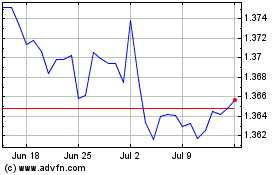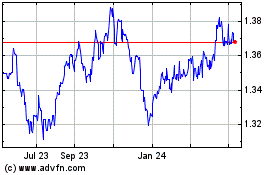Dollar Climbs Amid Robust U.S. Jobs Data, Narrowing Trade Deficit
August 04 2017 - 5:57AM
RTTF2
The U.S. dollar advanced against its major opponents in the
European session on Friday, as U.S. economy created more jobs than
forecast in July and trade deficit narrowed in June, raising
expectations for the possibility of a Fed rate hike by year
end.
Data from the Labor Department showed that non-farm payroll
employment surged up by 209,000 jobs in July after spiking by an
upwardly revised 231,000 jobs in June.
Economists had expected employment to climb by 183,000 jobs
compared to the addition of 222,000 jobs originally reported for
the previous month.
With the stronger than expected job growth, the unemployment
rate edged down to 4.3 percent in July from 4.4 percent in June.
The modest decrease matched economist estimates.
Data from the Commerce Department showed that the U.S. trade
deficit narrowed more than expected in the month of June,
reflecting an increase in exports and a decrease in imports.
The report said the trade deficit narrowed to $43.6 billion in
June from $46.4 billion in May. Economists had expected the deficit
to narrow to $45.0 billion.
The greenback held steady against its major rivals in the Asian
session, with the exception of the yen.
The greenback strengthened to weekly highs of 0.9723 against the
franc and 1.3084 against the pound, off its early lows of 0.9672
and 1.3164, respectively. Continuation of the greenback's uptrend
may see it challenging resistance around 1.00 against the franc and
1.28 against the pound.
The greenback, having fallen to near a 2-month low of 109.84
against the yen at 7:45 pm ET, reversed direction and climbed to
110.77. The greenback is poised to locate resistance around the
112.00 region.
Preliminary data from the Ministry of Health, Labor and Welfare
showed that Japan's total labor cash earnings decreased for the
first time in thirteen months in June, defying economists' forecast
for a further rise.
Gross earnings dropped 0.4 percent year-over-year in June,
reversing 0.6 percent rise in May, which was revised down from a
0.7 percent gain reported earlier. Meanwhile, it was expected to
increase by 0.5 percent.
The greenback appreciated 0.5 percent to a 2-day high of 1.1825
against the euro, after having fallen to 1.1889 at 3:00 am ET. The
next likely resistance for the greenback is seen around the 1.15
level.
Data from Destatis showed that Germany's factory orders
increased more than expected in June driven by domestic demand.
Orders grew 1 percent in June from May, when they increased by
revised 1.1 percent. Orders were forecast to grow moderately by 0.5
percent.
The greenback spiked up to a new 2-week high of 1.2638 versus
the loonie and a 9-day high of 0.7912 against the aussie, from its
early low of 1.2556 and a 2-day low of 0.7980, respectively. The
greenback is seen finding resistance around 1.28 against the loonie
and 0.77 against the aussie.
Reversing from an early 2-day low of 0.7455 against the kiwi,
the greenback bounced off to 0.7413. On the upside, 0.72 is likely
seen as the next resistance level for the greenback.
Looking ahead, Canada Ivey PMI for July is due shortly.
US Dollar vs CAD (FX:USDCAD)
Forex Chart
From Mar 2024 to Apr 2024

US Dollar vs CAD (FX:USDCAD)
Forex Chart
From Apr 2023 to Apr 2024
